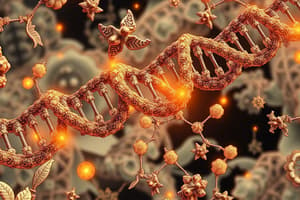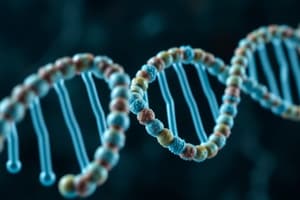Podcast
Questions and Answers
What is the main difference between the four nucleotides that make up DNA?
What is the main difference between the four nucleotides that make up DNA?
bases
Who figured out the three-dimensional structure of DNA by using a model of metal and wood?
Who figured out the three-dimensional structure of DNA by using a model of metal and wood?
Watson & Crick
In humans, where does DNA replication take place?
In humans, where does DNA replication take place?
nucleus
What is the function of the enzyme DNA polymerase during replication?
What is the function of the enzyme DNA polymerase during replication?
What does messenger RNA do during transcription?
What does messenger RNA do during transcription?
How often does transcription take place to produce all the protein that a cell needs?
How often does transcription take place to produce all the protein that a cell needs?
What does the central dogma state?
What does the central dogma state?
What are exons?
What are exons?
What binds with the repressor to activate the lac operon in bacteria?
What binds with the repressor to activate the lac operon in bacteria?
What is a mutagen?
What is a mutagen?
Where must a mutation occur if it is to be passed to offspring?
Where must a mutation occur if it is to be passed to offspring?
What is the complementary DNA sequence to CCGTACT?
What is the complementary DNA sequence to CCGTACT?
What would you use to figure out the sequence on the other strand of a DNA double helix?
What would you use to figure out the sequence on the other strand of a DNA double helix?
What is the complementary RNA sequence to the DNA sequence TAGAGTC?
What is the complementary RNA sequence to the DNA sequence TAGAGTC?
When does DNA replication occur?
When does DNA replication occur?
What does Crick's central dogma summarize?
What does Crick's central dogma summarize?
How many amino acids are coded for in the mRNA sequence CGAUACAGUAGC?
How many amino acids are coded for in the mRNA sequence CGAUACAGUAGC?
When does mRNA processing take place?
When does mRNA processing take place?
What are introns?
What are introns?
How does the ribosome interact with mRNA and tRNA during translation?
How does the ribosome interact with mRNA and tRNA during translation?
What happens when the ribosome encounters a stop codon?
What happens when the ribosome encounters a stop codon?
Where does translation occur?
Where does translation occur?
What is the function of an amino acid?
What is the function of an amino acid?
What is the start codon and the nucleotide sequence for the corresponding anticodon?
What is the start codon and the nucleotide sequence for the corresponding anticodon?
How does a frameshift mutation (insertion) affect the way the mRNA is read?
How does a frameshift mutation (insertion) affect the way the mRNA is read?
How would a frameshift mutation (insertion) affect the structure of the resulting protein?
How would a frameshift mutation (insertion) affect the structure of the resulting protein?
If a frameshift mutation occurred in a body cell, would the offspring be affected?
If a frameshift mutation occurred in a body cell, would the offspring be affected?
What are the 3 ways that RNA differs from DNA?
What are the 3 ways that RNA differs from DNA?
Name the 3 stop codons.
Name the 3 stop codons.
Flashcards
DNA Bases
DNA Bases
Adenine, thymine, cytosine, and guanine are the four nitrogenous bases that make up DNA.
DNA Structure Discovery
DNA Structure Discovery
The three-dimensional structure of DNA was discovered by Watson and Crick using a model made of metal and wood.
DNA Replication Location
DNA Replication Location
In the nucleus of human cells, DNA is replicated, creating an identical copy.
DNA Polymerase
DNA Polymerase
Signup and view all the flashcards
DNA Replication Frequency
DNA Replication Frequency
Signup and view all the flashcards
mRNA Function
mRNA Function
Signup and view all the flashcards
Transcription Repetition
Transcription Repetition
Signup and view all the flashcards
mRNA Processing
mRNA Processing
Signup and view all the flashcards
Central Dogma
Central Dogma
Signup and view all the flashcards
Crick's Central Dogma
Crick's Central Dogma
Signup and view all the flashcards
Start Codon
Start Codon
Signup and view all the flashcards
Anticodon for AUG
Anticodon for AUG
Signup and view all the flashcards
Triplet Code
Triplet Code
Signup and view all the flashcards
Codon Example
Codon Example
Signup and view all the flashcards
Translation Location
Translation Location
Signup and view all the flashcards
Mutagens
Mutagens
Signup and view all the flashcards
Heritable Mutations
Heritable Mutations
Signup and view all the flashcards
Frameshift Mutation
Frameshift Mutation
Signup and view all the flashcards
Body Cell Mutations
Body Cell Mutations
Signup and view all the flashcards
RNA vs. DNA
RNA vs. DNA
Signup and view all the flashcards
RNA Sugar
RNA Sugar
Signup and view all the flashcards
RNA Strand
RNA Strand
Signup and view all the flashcards
RNA Base
RNA Base
Signup and view all the flashcards
Stop Codons
Stop Codons
Signup and view all the flashcards
Stop Codon Function
Stop Codon Function
Signup and view all the flashcards
Study Notes
DNA Structure and Function
- Four nucleotides in DNA differ by their bases: adenine, thymine, cytosine, and guanine.
- Watson and Crick discovered the three-dimensional structure of DNA using a model made of metal and wood.
DNA Replication
- In humans, DNA replication occurs in the nucleus.
- DNA polymerase is the enzyme that binds nucleotides together during replication.
- Replication happens once in every cell cycle.
Transcription and mRNA Processing
- Messenger RNA (mRNA) carries DNA instructions to synthesize proteins.
- Transcription occurs repeatedly on a gene segment to produce adequate protein levels.
- mRNA processing involves splicing exons together and removing introns.
Central Dogma of Molecular Biology
- The central dogma outlines the information flow from DNA to RNA to proteins.
- Crick's summary encompasses replication, transcription, and translation.
Codons and Translational Mechanics
- The start codon is AUG, with the corresponding anticodon UAC.
- mRNA codons are read in groups of three, known as the triplet code; for example, the sequence CGAUACAGUAGC codes for 4 amino acids.
- Translation takes place in the cytoplasm, where the ribosome binds to mRNA and attracts tRNA carrying methionine to the start codon.
Mutations and Their Effects
- Mutagens are environmental agents that can alter DNA.
- Mutations that can be inherited must occur in germ cells.
- A frameshift mutation (insertion) shifts the reading frame, potentially altering the resultant protein's amino acid sequence and structure.
- Frameshift mutations in body cells do not affect offspring since they are not passed to gametes.
RNA vs. DNA
- RNA differs from DNA in three significant ways:
- RNA contains ribose, while DNA contains deoxyribose.
- RNA is single-stranded compared to DNA’s double-stranded structure.
- RNA uses uracil (U) instead of thymine (T).
Stop Codons
- There are three stop codons: UAA, UAG, and UGA, which signal the termination of protein synthesis.
Studying That Suits You
Use AI to generate personalized quizzes and flashcards to suit your learning preferences.
Description
Test your knowledge on Chapter 8 from DNA to Proteins with these interactive flashcards. Explore essential concepts including nucleotide differences, DNA structure, and replication processes. Perfect for revision and understanding key biological principles.



